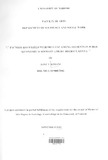| dc.description.abstract | Drugs are known to have harmful effects yet young people still use them. The study sought to find out the factors that contribute to use of drugs by students in secondary schools. The study was conducted to investigate the reasons why secondary school students use the drugs. A descriptive study was undertaken in 3 schools in Limuru District. TT1e study had 200 student respondents, three guidance and counseling teachers, two head teachers and one deputy head teacher as the participants in the study. Both qualitative and quantitative data were used in the study.
Qualitative data was collected from the key informants who were guidance and counseling teachers and the head teachers through interviews. Quantitative data was gathered from students using a questionnaire. Qualitative data was analysed using thematic method whereby the data collected from key informants was grouped under emerging themes as per the research objectives. Quantitative data was analysed using descriptive statistic frequencies and percentages. Quantitative data was presented in form of tables and figures. Qualitative data was presented in a narrative form
The study revealed that the most commonly used drugs include alcohol, cigarettes, bhang and miraa. These drugs are readily available and are also affordable to the students. The drugs were also found to be popular among the larger Kenyan population. The drugs used by students are obtained from other students, school workers, social gatherings, bars, sellers around the school and the black market. The study also found out that personal and social factors contribute to drugs and substance use. Students in Form Two were found to be more prone to using drugs than those in other classes and age groups.
Socially, family set up, family conflict, values and beliefs of the community around school contributes to drugs and substance use among students. Where parents \vere more involved in the upbringing of their children and monitoring of their activities. the children rarely engaged in use of drugs. Economic factors also contribute to drug and substance use by students. Thus. the study found that where the amount of money at the disposal of students and family income is high. the students are more likely to afford and use drugs.
Drugs like cocaine and heroin were only used by students coming from rich families. The study makes a number of recommendations: There should be increased public awareness campaigns to bring out dangers of drugs by involving the media. civic education and administration. Parents should take a more active role in the upbringing of their children. A clear drugs policy in schools and training teachers on how to address the problem of drug use is also recommended. The study also calls upon the society to re- evaluate its morals with regard to how it treats drug users and drug lords. The study also calls for further in- depth research into how the identified factors lead to use of drugs among students.
The study concludes that social and economic factors are the main factors which can be used to explain the use of drugs among students in secondary schools. These factors determine whether a student would engage in drug use as they shaped his or her preferences. The way students are brought up, who they associate with and whether they can access money to buy the drugs largely contributes to drug use. | en_US |

